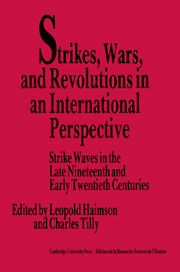 Strikes, Wars, and Revolutions in an International Perspective
Strikes, Wars, and Revolutions in an International Perspective Book contents
- Frontmatter
- Contents
- List of contributors
- Preface
- Part I Introductions
- Part II Models and realities
- 3 Introduction
- 4 Changing forms of labor conflict: secular development or strike waves?
- 5 Strikes and power in Britain, 1870–1920
- 6 Two strike waves in Imperial Russia, 1905–1907, 1912–1914
- 7 Strikers in revolution: Russia, 1917
- 8 Strikes in Imperial Russia, 1895–1913: a quantitative analysis
- 9 Labor conflicts in Italy before the rise of fascism, 1881–1923: a quantitative analysis
- 10 Strikes and politics in the United States, 1900–1919
- Part III Workers in metal-processing enterprises in comparative perspective
- Part IV The effects of short-term variation
- Part V Conclusion
8 - Strikes in Imperial Russia, 1895–1913: a quantitative analysis
Published online by Cambridge University Press: 25 March 2010
- Frontmatter
- Contents
- List of contributors
- Preface
- Part I Introductions
- Part II Models and realities
- 3 Introduction
- 4 Changing forms of labor conflict: secular development or strike waves?
- 5 Strikes and power in Britain, 1870–1920
- 6 Two strike waves in Imperial Russia, 1905–1907, 1912–1914
- 7 Strikers in revolution: Russia, 1917
- 8 Strikes in Imperial Russia, 1895–1913: a quantitative analysis
- 9 Labor conflicts in Italy before the rise of fascism, 1881–1923: a quantitative analysis
- 10 Strikes and politics in the United States, 1900–1919
- Part III Workers in metal-processing enterprises in comparative perspective
- Part IV The effects of short-term variation
- Part V Conclusion
Summary
Born at the dawn of the labor movement, the strike remains to this day one of the main forms of proletarian class struggle in capitalist society. At different stages of the labor movement it performed different functions, being remarkably adapted to the solution of the tasks posed by this movement. As a form of worker collective action to counter the intensification of their exploitation by capitalists, strikes connected closely with fluctuations in economic conditions. With the growth of class consciousness of the proletariat, its organization, and the utilization of the strike as a means of political struggle, this connection began to weaken.
The strike cannot resolve the contradiction between labor and capital that engendered it. In the middle of the 1840s, Marx and Engels pointed out that “real strikes in civilized countries are always a subordinate part of the labor movement, because more general combinatioins of workers lead to other forms of actions.”
At the same time, the proletariat's constant employment of the strike in its struggle, the different functions performed by it depending on the aims pursued by this struggle, the ability of the strike movement to reflect the level of workers' class consciousness, the proletariat's role in the solution of pressing social contradictions – all this lends special importance to studying the dynamics of the strike movement in the historical analysis of social relations in the capitalist epoch. Lenin said in 1913 that “the Russian workers' strike movement is the best barometer of the entire nation-wide emancipation struggle in Russia.”
- Type
- Chapter
- Information
- Strikes, Wars, and Revolutions in an International PerspectiveStrike Waves in the Late Nineteenth and Early Twentieth Centuries, pp. 197 - 216Publisher: Cambridge University PressPrint publication year: 1989


